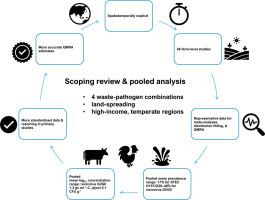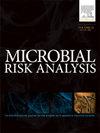在高收入、温带地区土地传播的四种废物-病原体组合的流行率和浓度——范围审查和汇总分析
IF 4
4区 环境科学与生态学
Q2 ENVIRONMENTAL SCIENCES
引用次数: 0
摘要
在高收入、温带地区,动物浆和废水处理污泥是有价值的生物肥料,并作为可持续的农业废物管理实践支持转型农业粮食系统。然而,在陆地传播的生物废物中存在的肠道病原体构成了公共卫生风险,食物和水是关键的传播途径。通过定量微生物风险评估(QMRA),缺乏高收入、温带地区具有时空代表性的病原体流行率和浓度数据来估计风险。对高收入温带地区陆地传播的四种废物-病原体组合(即牛浆液-产大肠杆菌血清群O157/O26、牛浆液-小隐孢子虫、肉鸡粪便-空肠弯曲杆菌和wwts -诺如病毒基因群GI/GII)进行了时空明确的范围审查。从46个农场水平的研究中提取、协调和汇总W-PC患病率和浓度数据,除了提供单个研究患病率和浓度外,还获得了这些地区土地分布的meta分析、分布拟合和QMRA的代表性数据。在提取的研究中,每种W-PC的汇总平均患病率和生物废物样本总数从STEC O157/O26的17% (N = 14,204)到诺如病毒GI/GII的48% (N = 1027)不等。这些一般估计包括特异性和非特异性数据(即血清群、种和亚种或基因群),因此应谨慎解释。混合平均浓度和SD浓度从诺如病毒GI/GII 1.3、0.5 log10 gc ml-1到空肠C. 5.1、0.7 log10 CFU g-1。在研究中发现了时空异质性、非标准化报告和研究设计偏差。因此,需要在初级研究中增加标准化数据和报告,以获得更准确的QMRA估计。此外,汇集异质的二手数据,就好像它们是同质的一样,会引入一般误差,因此,强调了对这些数据的未来荟萃分析和分布拟合的需求,以表征研究间和研究内的可变性,以及来自环境来源的不确定性和可变性。本文章由计算机程序翻译,如有差异,请以英文原文为准。

The prevalence and concentrations of four waste-pathogen combinations from land-spreading across high-income, temperate regions – A scoping review and pooled analysis
Animal slurries and wastewater treatment sludges (WWTS) represent valuable biofertilisers in high-income, temperate regions and support transformative agri-food systems as sustainable, agricultural waste management practice. However, the presence of enteric pathogens in land-spread biowastes pose a public health risk, with food and water being critical transmission pathways. A dearth of spatiotemporally representative pathogen prevalence and concentration data from high-income, temperate regions exists to estimate the risk, achievable through quantitative microbial risk assessment (QMRA). A spatiotemporally explicit scoping review was undertaken of four waste-pathogen combinations (W-PCs) (i.e., bovine slurry-STEC serogroups O157/O26, bovine slurry-Cryptosporidium parvum, broiler litter-Campylobacter jejuni, and WWTS-norovirus genogroups GI/GII) from land-spreading in high-income, temperate regions. W-PC prevalence and concentration data from 46 farm-level studies were extracted, harmonised, and pooled, to obtain representative data for meta-analyses, distribution fitting, and QMRA from land-spreading across these regions in addition to providing individual study prevalence and concentrations. Pooled mean prevalence and the total number of biowaste samples across extracted studies for each W-PC ranged from 17 % for STEC O157/O26 (N = 14,204) to 48 % for norovirus GI/GII (N = 1027). These general estimates included specific and non-specific data (i.e., serogroups, species and subspecies, or genogroups), and thus, should be interpreted with a level of caution. Pooled mean and SD concentrations ranged from norovirus GI/GII 1.3, 0.5 log10 gc ml-1 to C. jejuni 5.1, 0.7 log10 CFU g-1. Spatiotemporal heterogeneity, unstandardised reporting, and study design biases were found across studies. Therefore, increased standardised data and reporting in primary studies are required for more accurate QMRA estimates. Furthermore, pooling heterogeneous secondary data as though they were homogeneous introduces general error, and hence, highlights the requirement for future meta-analyses and distribution fitting of these data to characterise the inter- and intra- study variability in addition to uncertainty and variability from environmental sources.
求助全文
通过发布文献求助,成功后即可免费获取论文全文。
去求助
来源期刊

Microbial Risk Analysis
Medicine-Microbiology (medical)
CiteScore
5.70
自引率
7.10%
发文量
28
审稿时长
52 days
期刊介绍:
The journal Microbial Risk Analysis accepts articles dealing with the study of risk analysis applied to microbial hazards. Manuscripts should at least cover any of the components of risk assessment (risk characterization, exposure assessment, etc.), risk management and/or risk communication in any microbiology field (clinical, environmental, food, veterinary, etc.). This journal also accepts article dealing with predictive microbiology, quantitative microbial ecology, mathematical modeling, risk studies applied to microbial ecology, quantitative microbiology for epidemiological studies, statistical methods applied to microbiology, and laws and regulatory policies aimed at lessening the risk of microbial hazards. Work focusing on risk studies of viruses, parasites, microbial toxins, antimicrobial resistant organisms, genetically modified organisms (GMOs), and recombinant DNA products are also acceptable.
 求助内容:
求助内容: 应助结果提醒方式:
应助结果提醒方式:


